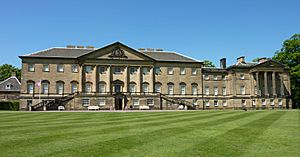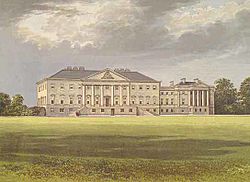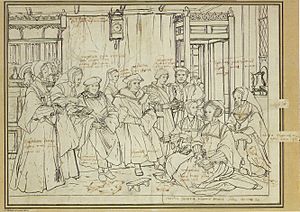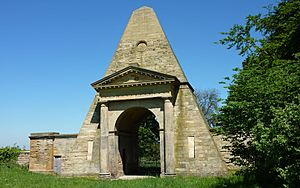Nostell Priory facts for kids
Nostell Priory is a grand old house in Nostell, near Wakefield, West Yorkshire, England. It's built in a special style called Palladian. Construction began in 1733 for the Winn family, on the site where a medieval priory once stood. In 1953, the house and its amazing collections were given to the National Trust, so everyone can enjoy them.
Contents
A Look Back at Nostell Priory's Story

The land where Nostell Priory stands has a long history. In 1567, the Gargrave family bought the property. Later, in 1654, Sir Rowland Winn, a successful merchant from London, purchased the estate.
Building the Grand House
The Winn family became very wealthy, first from their textile business and later from the coal found under their land. They also made money by leasing land for iron ore mining during the Industrial Revolution. This wealth allowed them to build the beautiful house we see today.
Work on the current house began in 1733. James Paine was the first architect. Later, a famous architect named Robert Adam was hired to add more parts to the house and finish the main rooms. Adam designed a special double staircase at the front and other buildings, including the stable block. Many of the original furnishings and decorations are still inside the house.
Amazing Collections at Nostell Priory
Nostell Priory is home to a huge collection of furniture made by Thomas Chippendale. All these pieces were specially made for the house. Chippendale was a famous furniture maker from England.
The house also has an impressive art collection. You can see paintings like The Procession to Calvary by Pieter Brueghel the Younger. There's also Scene from Shakespeare's The Tempest by William Hogarth, which is the first painting ever to show a scene from a Shakespeare play. A self-portrait by Angelica Kauffman is also on display.
One special painting is a copy of Sir Thomas More and Family by Hans Holbein the Younger. The original painting is now lost, but this copy, made in 1592, is thought to be very accurate.
John Harrison's Famous Clock
In the billiard room, you can find a unique longcase clock made by John Harrison in 1717. What's special about it is that almost all its inside parts are made of wood! Harrison was born very close to the estate. He became famous for solving the problem of finding longitude at sea. He created very accurate clocks for ships. His most famous clock, called H4, is now at the Royal Observatory, Greenwich in London.
Recent History and Openings
In the 1980s, Nostell Priory hosted music festivals. These events brought many people to the estate.
In 2007, some beautiful furniture made by Gillows returned to the house after being restored. These pieces now decorate the tapestry room. The stable block, designed by Robert Adam, has also been renovated and is now a visitor centre.
Since 2009, more parts of the house have opened to the public. This includes bedrooms on the second floor, which still have their original furniture. Visitors can also see the butler's pantry, where the Winn family's silver collection is displayed.
Exploring Nostell Priory's Grounds
Nostell Priory has 121 hectares (about 300 acres) of beautiful parkland. You can enjoy peaceful walks by the lakes and through the woodlands. The main part of the house faces a large grassy area. On the west side, there's a lawn leading down to a lake.
You can also walk to the restored Obelisk Lodge, which is a gatehouse in the park. The parkland was bought by the National Trust with help from the Heritage Lottery Fund. This funding also helped the Trust acquire many of the pictures, books, and furniture from the Winn family. The Obelisk Lodge was built in the 17th century.
Community and Modern Use of the Grounds
The large lawns at Nostell Priory have been used for many events over the years. In 2000, the "Central Yorkshire Scout County" held a big "Millennium Camp" there. About 2,500 Scouts from across Yorkshire attended. To prepare for this event, a water company helped install a new underground water system. This was a huge improvement for the Priory, making it easier to host large events.
In 2012, permission was given for a new base for the Yorkshire Air Ambulance at Nostell Priory. This new facility, including a hangar and crew accommodation, opened in 2013. It helps the air ambulance quickly reach people who need help.
Nostell's Monastic Past
Before the grand house, Nostell was home to a 12th-century priory. It was an Augustinian foundation, meaning it was a community of religious canons. It was dedicated to Saint Oswald.
Around 1114, Aldulf, who was a confessor to King Henry I of England, was the prior (leader) of the canons at Nostell. It's believed that John Field, an early English astronomer who studied the ideas of Copernicus, learned at Nostell when he was young.
In 1540, during the time known as the Dissolution of the Monasteries, the priory was taken over by the Crown. After this, the lands of the priory came into the hands of Sir Thomas Gargrave.
See also
 In Spanish: Nostell Priory para niños
In Spanish: Nostell Priory para niños








